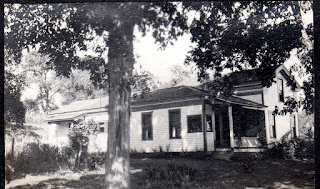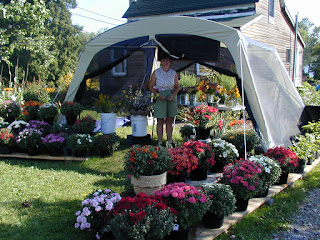History fascinates me. I'm always eager to share the origins of the farm's name. It's one of the most frequently asked questions of the farm.
Surely you've heard of other farm names, e.g., Elmhurst Dairy, Maplehurst Farm. I bet you've also heard of town or street names such as Pinehurst or Lindenhurst. Looking at the etymology of hurst, its origins trace back to hyrst, in Old English, which means hillock, grove, eminence, or wooded sandbank. Aptly put, since my great-grandparents encountered numerous shagbark hickory trees--a grove--surrounding the farmhouse when they moved to the farm in 1908. A photo from 1920 shows at least two hickory trees shading the farmhouse in mid-summer (photo below). This photo looks northwest from the southeast corner of the farm.
 |
| Hickory Hurst Farm, 1920 |
Another photo taken the same day, yet father away, includes the main barn and the shagbark hickories towering over the farmhouse in the right side of the photo. One family story handed down to me was that lightning struck and decimated the hickory tree in the right foreground (of the same photo). As a child, I vaguely remember playing in the pasture around the remnants of that stump. Numerous volunteer seedlings over the years would supplant the void left by that tree.
 |
| Hickory Hurst Farm pasture, 1920 |
Shagbark hickory trees are native to western New York State and to the eastern half of the United States. They tend to develop a deep tap root, grow slowly, and have a long life. A relative of the black walnut, they produce a substance called juglone, which inhibits the growth of other plants within their vicinity. Shagbark hickories tend to produce juglone at lower concentrations than their cousin; nevertheless, the juglone still impedes the growth of certain plants. Shagbark hickories do produce edible nuts that add delicious flavor to quick breads, cakes, and cookies. Squirrels and chipmunks hoard the nuts for winter fodder, too.
Speaking of longevity, the shagbark hickory that currently looms in front of the farmhouse is approximately 200 years old. The position of the current tree in respect to the house is most surely the same tree as seen in this 1875 photo when Norman Newbury owned the farm (photo below). Another photo taken more than a century later gives another perspective from a different vantage point.
 |
| Norman Newbury residence, 1875 (forerunner of Hickory Hurst Farm) |
 |
| Hickory Hurst Farm, 1979 |

